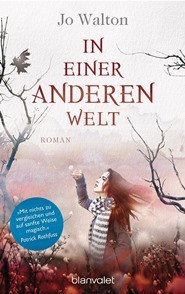The Prize in the Game was published by Tor in 2002, and by Corsair in the UK as an ebook in 2013. It’s my third pubished novel and my non-selling book.
It’s a version of the Irish story of the Tain Bo Cuailgne, set in the world of the Sulien books. It features some of the minor characters in those books, before they appear there. It’s essentially their backstory. I had the idea for it by considering that the names Guinevere (Gwynhwyfar) and Fionnbharr are etymologically identical, and considering that if Fionnbharr in the Tain grew up to be Guinevere that would explain some of Guinevere’s subsequent behaviour. That’s where I got Elenn from. Her sister Emer came from the “doubling” of Guinevere in a number of sources, where Guinevere has a “bad” sister. I put Emer and Elenn into the Sulien books grown up and formed, and then discovered that fewer people know the Tain than I had imagined. I wrote The Prize in the Game to elucidate this. This is the story of fifteen year olds in a warrior culture. It was interesting taking characters I already knew well as adults, and where I had already written the ends of their stories (in Conal’s case even his death) and writing about how they came to be those people.
The other thing I was interested in doing with it was considering what it’s like to live with a legend. The legends in the Tain are Cuchulain, here Darag, and Maeve, here Maga. They’re the ones people tell stories about. I was more interested in the people around them — Conal Cearnach, the second-best warrior in all Ireland, Elenn, the daughter Maga offers in marriage to warrior after warrior who’ll try to kill Darag. Elenn and Emer are very different from each other, but each formed in reaction to their mother. Conal is formed in reaction to his parents but also to Darag. Conal and Emer fall in love. The fourth point of view character is Ferdia, who was a fascinating challenge to write — gay, a warrior, just a little slower than his friends, and terribly in love with Darag. I found Ferdia ferociously difficult to write, but now I think he’s the best thing in the book.
The Sulien books were written in first person, and I was determined to write this in third. It’s in four very tight third points of view that alternate in strict rotation — nobody notices this, and it was a challenge but it gave me at least as much as it cost me. I wrote the book in 2001. Most of it was written before 8am.
Publishers’ Weekly review.
FREQUENTLY ASKED QUESTIONS
Q Is this a sequel to the Sulien books?
A. It’s a prequel. And it’s about Elenn and Emer and Conal and Atha and Inis, not about any of the main characters of the Sulien books.
Q Why didn’t it sell?
A. I don’t know. It could have been the cover, or the timing, or just that it wasn’t the kind of thing people wanted or were expecting. I don’t think it’s any worse than my other books.
Q Why did you change some but not all of the names?
A. It’s to do with the way the world works.
Q How does the world work, then?
A. The physical world is the same as our world, and the mythically significant things happen the same way. If they don’t, the world gets the legend without the physical event — as in our world with Arthur. It’s the legend that matters. So names don’t matter, and people have different names and play the same role… and mostly I changed the names, but with Conal and Ferdia I didn’t because they felt right as they were.
Q. Isn’t that really complicated?
A. Oh yes. Inis does explain it’s how he does foretelling, he sees what happened in other worlds, and therefore has a probability of happening in theirs.
Q. Did you have to do all that to get a version of C.6 Britain with magic?
A. It wasn’t the magic, it was women having a feudal obligation to fight. It took a lot of tweaking all over to get that.
Q. What about the magic though?
Well, in some worlds the gods are really powerful, and in others they’re really withdrawn. In this world they usually need human will to act through. And the gods are connected to place and kings, except for the White God, of course, and we see Rhianna and Gangrader directly affecting things.
Q isn’t that really complicated?
I like complicated. And I have to do all this to be comfortable with a fantasy world that has people and horses, because otherwise I spend all my time trying to work out how it does. It’s a problem I have. Don’t worry about it.
Q Is it historically accurate?
A. For my alternate world? Sure.
Q Can you recommend a version of the Tain?
A It’s surprisingly badly translated. I recommend the Sullivan one, but it’s not great. The Faraday is at least free.
Q How close is PitG to the Tain, compared to the Sulien books with Arthur?
A. Much, much closer.
Q. Are you going to write a sequel?
A. Sorry, no.



